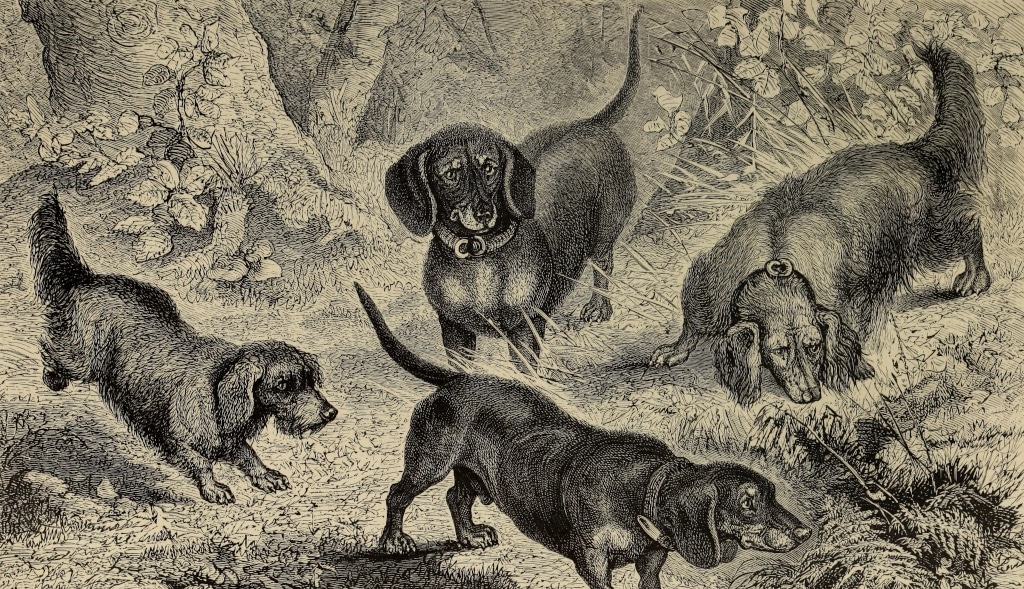Today (2016) in her proud 93rd year, a dignified lady lives in Dutch Gelderland in a former servants’ house. She looks back on a long, fulfilling life accompanied by many dachshunds. The body no longer wants to do right and has developed its own peculiarities, but the lady knows that she is being cared for and in good hands. She took, she created a work, she gave.
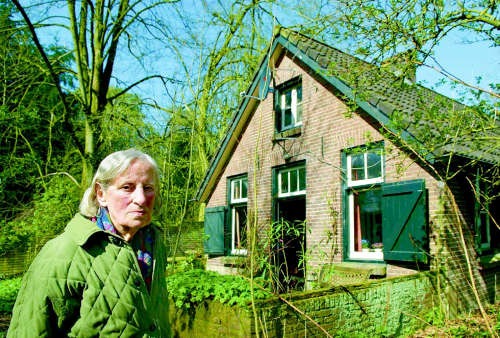
Enny’s Hoeve and the Dachshund Kennel “van de Zeven Bergjes”
This servants’ house once belonged to a secluded and lonely farmstead in the middle of extensive forests, where cattle and chickens were mainly raised. From 1919 on Enny’s Hoeve was built south of the municipality of Putten in Voorthuizen as a manor house by the wealthy Mr. Hendrik Pouw and his then 18-year-old wife Paulina Berta Elisabeth Margareta Neumann, who came from the Klein Heinersdorf manor (today: Zagórze) about 50 km east of Frankfurt (Oder).
It seems important to me to point out, that we do not know anything about the couple’s motives for the marriage, which took place in 1918 and thus at a historically suspicious time. Was it “love” from the start, and if so, where and how did the two meet during the First World War? Was it young Miss Neumann’s escape from the foreseeable defeat of Germany and the looming upheavals, or fear that the Russian October Revolution would also spread to Germany? Let’s not forget that there were a number of people who left Germany at the time because the end of the monarchy, which they saw as the only natural form of government, was in sight since the failure of the German spring offensive. The Allied successes on the western front, and the emerging republic seemed to be unbearable to them. All speculation, of course. Nevertheless, I would like to warn you of putting Fraulein Neumann in a drawer prematurely.
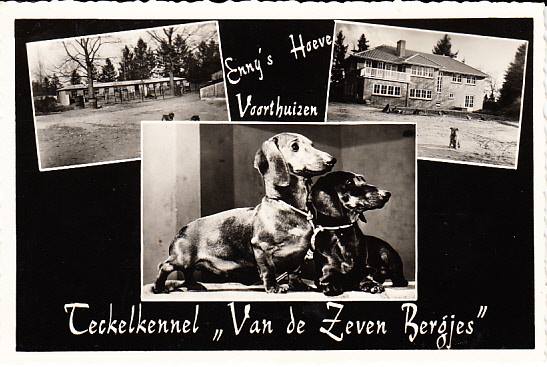
Mrs. Greta Pouw-Neumann, as she was initially to call herself, founded the dachshund kennel “van de Zeven Bergjes” in 1925 and soon took on a leading role in short-haired dachshund breeding together with her husband, who, however, acted much more reservedly and less publicly with at least the same level of competence. The actual basis of their breeding was formed by mating Edel Bommelia (red) x Perle v. Falkenried (black and tan). In addition, she worked with dogs from the kennel “v. Flottenberg” in Neu Babelsberg near Potsdam operated by Mr. G.F. Müller and a small kennel near Munich called “v. Luitpoldsheim” by the Sensenbrenner couple.
As she later frankly said herself, she had made a very lucky strike with this combination. She was well aware of the value of her luck, for she felt that no amount of study and comparison of pedigrees could have compensate for it. Nevertheless: modesty wasn’t her thing. From today’s point of view, Mrs. Pouw served the cliché of a resolutely sole ruler and you should be careful not to let arise the romanticizing idea of a lady with an indulgent smile surrounded by her five spoiled dachshunds. Nothing could be more wrong.
She was born on February 28, 1901 as the daughter of the manor owner Adolf Friedrich Neumann and his wife Paulina Margareta Neumann, née Frischmüller, and grew up in the Neumark, one might say upper-class. When she was 17, she married a rich and 14 years elder landowner and was in charge of a large house. So it is not surprising that throughout her life she insisted that everyone should stand up when Mrs. Pouw entered the hall and only sits down again when the lady of the house had sat down at the table herself.
For the care of the numerous dogs Ms. Pouw had her servants, who in turn were ruled by employees, who were also responsible for the training and presentation of the dogs at tests and exhibitions. On important occasions she was present in person, but only to accept prizes, to maintain contacts or just to take a look at other dachshunds. This is not a judgment in questions of character. Ms. Pouw may have been shaped by times and circumstances that are simply foreign to us today.
Although this is not the place to go into detail about the breeding activities in this kennel, which existed for more than 51 years until 1976, I would like to let Ms. Pouw speak for herself (according to the commemorative publication “Honderd jaar Teckels in Nederland” published by the Nederlandse Teckel Klub in 2003 from the magazine “De Hond” (1940) quoted), because here a piece of this extraordinary breeder’s personality seems to become tangible:
“All over the country the pressure of these troubled times is being felt,” she wrote in January 1940. “Dog sports is also suffering. There will probably be no kennel that is not affected. Although the situation of supply is still sufficient to do justice to one’s dogs, it is becoming noticeably harder, especially since sales are now falling sharply. There is still nothing to justify a mood of panic among the Dutch cynologists, even if here and there it is already being pretended that the whole Netherlands is threatened with starvation! Fortunately, these are isolated cases so far. But what will happen if food rations are actually reduced and sales fall even further? (…) Well, I would like to assume that among the dachshund lovers there will be some who, regardless of this, continue with the necessary caution and deliberation. On the other hand, however, those breeders will disappear from our ranks for whom the fun stops when the profit dwindles! That’s not something I could really mourn! The greater the possibilities, the sharper the selection. Our Dutch dachshunds are often made of good stuff. The good ones will prevail. The rest that will disappear does not deserve to be mourned.”
Greta Pouw
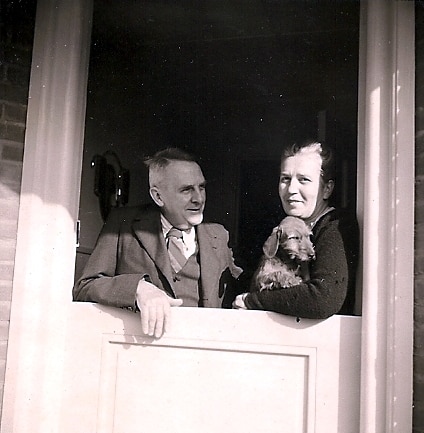
Only a few months later, in May 1940, the German Wehrmacht invaded the Netherlands and Mevrouw Pouw was compelled to act accordingly to a much greater degree than she might have imagined when she wrote the lines.
In the years before the German occupation, there were more than ten litters in the kennel v.d. Zeven Bergjes not particularly noteworthy, but the number of litters fell to seven in 1940 and went back to five the following year. However, until 1945 there were hardly any litters. However, this did not necessarily have to do with the situation of supply in the Netherlands occupied by us Germans. The Pouw family had resisted the German occupiers in one way or another. On the one hand, Enny’s Hoeve housed ten Jewish Dutchmen in hiding; on the other hand, particularly after the Allied landings in Normandy and the Battle of Arnhem, Enny’s Hoeve became a rallying point for active resistance fighters, German deserters and Allied parachutists who had landed behind the lines.
The Attack of Putten
So it came about that on September 30, 1944, eight men met on Enny’s Hoeve and set out from there to attack a Wehrmacht vehicle occupied by German officers in the municipality of Putten. The attack as such failed. A firefight ensued in which two German officers were wounded. One of the officers was injured so badly that he died the following day. The other one was captured injured by the resistance fighters. Two other German officers escaped unharmed and alerted the occupying forces stationed in Harderwijk.
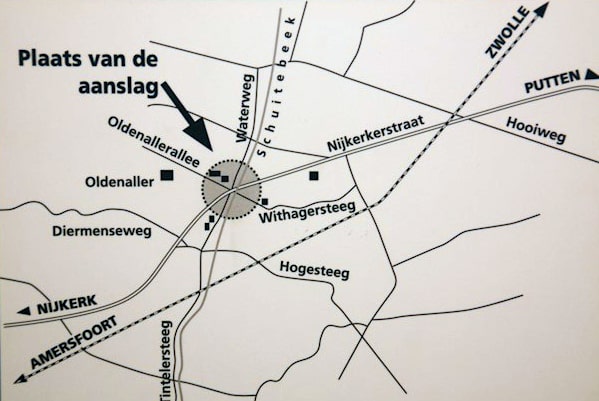
Assassination attempt on the German occupying forces (September 30, 1944) | Source: The Attack
On the following October 1, 1944, by order of the German General of the airman Friedrich Christiansen, Wehrmacht Commander of the occupied Netherlands and Commander-in-Chief of the 25th Army, the village of Putten, on whose territory the attack had taken place, was hermetically sealed off. All houses were searched, all residents rounded up. Women and children were herded together in the Old Church; the men at the local school and the egg hall. Seven people have already been shot dead by German soldiers in their desperate attempts to escape. On the following day, all male children from the age of 15 and all men up to the age of 50, a total of 661 people, were deported via the police transit camp in Amersfoort and the Neuengamme concentration camp to various concentration camps in northern Germany.
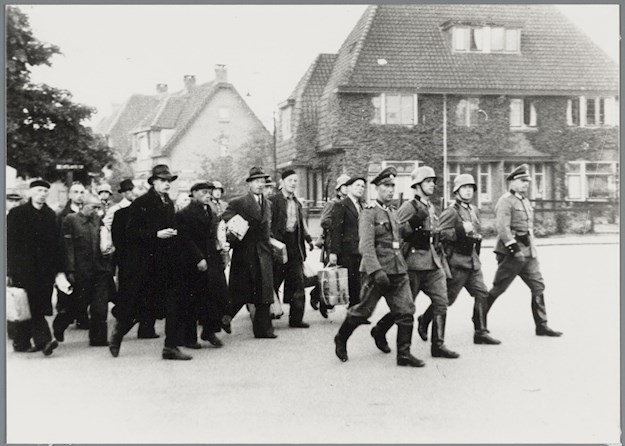
About a thousand soldiers from the “Hermann Göring” regiment are driving the residents into the village center under police supervision | Hoek Dorpsstraat – Kerkstraat, Putten, The Netherlands
Source: The Raid
Five hundred and fifty-two times, hope lost a race against time. Only weeks until the liberation of the Netherlands, only a few months until Germany began to know nothing about everything, were enough to send these human lives into a rendezvous with death, five hundred and fifty-two times, with nothing but loneliness and five hundred and fifty-two tunes of unique table music carefully composed from hatred, hunger, abuse and forced labour, from exhaustion, fear and cold. When spring came, Europe breathed a sigh of relief and life could begin again, the women and families in Putten also waited for these five hundred and fifty-two boys and men. They waited in vain. Putten had literally become the village of widows.
General Christiansen was sentenced to 12 years’ imprisonment as a war criminal by a Dutch special court in 1948 and pardoned by the Netherlands in 1951. On his release, his native town of Wyck on the island of Föhr renewed the honorary citizenship it had granted him in 1932, as did the town of Aukrug, where he lived, with regard to the honorary citizenship it had granted him in 1933, and again named a street after him. After all, he was an honourable and brave German soldier.
Of course, the people on Enny’s Hoeve did not miss the looming war crime of the German army in the neighbouring community of Putten. A heated discussion arose among the resistance fighters about the captured Lieutenant Eggert. In view of the events in Putten and the danger to the resistance group, some argued that Lieutenant Eggert should be shot, while others did not want to put themselves on the same level as the Germans and let the prisoner live despite the consequences this would probably have.
Finally, humanity -or Mevrouw Pouw- prevailed and it was agreed that after first aid had been administered, Lieutenant Eggert would be placed in a car on a road. Attached was a note in German and Dutch asking to notify the nearest German post if found. The inhabitants of Enny’s Hoeve had no illusions about the danger it meant for them to have left Oberleutnant Eggert alive, and in all haste they fled from Enny’s Hoeve to the four winds and an initially uncertain future for everyone, despite the already foreseeable end of the war. Only one daughter of the family, Coob Pouw, stayed behind to look after the animals.
The Revenge of the Wehrmacht on Enny’s Hoeve
First Lieutenant Eggert was found. After his interrogation was completed, he could not report much, but that he had been in a place where he had heard a remarkably large number of dogs barking. That sealed the end.
On October 18th 1944, Enny’s Hoeve was initially surrounded by German occupation troops. No one was to be able to escape. Wehrmacht soldiers searched Enny’s Hoeve and captured Coob Pouw, who was released a month later. Enny’s Hoeve, however, was set on fire and completely destroyed.
Imagine the burning field of rubble. In between, German soldiers carry out shooting exercises on dachshunds, which have never known anything bad from humans. One dog after the other is killed. Piffpaff! That was the dog with the funny ears. Piffpaff! The beautiful red one. Piffpaff! There lies the mother dog of four litters. Piffpaff The tiger is history, no, badly shot, only the front leg now dangles strangely from the dog. Piffpaff, piffpaff, piffpaff! There’s the veteran! Piff! Paff! Dead.
We are not talking about two or three dogs, nor ten or fifteen. At times, up to 200 dogs are said to have lived in the world’s largest dachshund kennel on Enny’s Hoeve, although we may assume that considerably fewer dogs were still on site towards the end of the war. Most of the magnificent dachshund breeding was stolen by the so honourable and brave German soldiers. Who knows under which name and in which post-war pedigrees they or their descendants may have reappeared? Those whose value was not recognized or who could not be caught were shot, and only a few dogs were able to flee into the woods in panic.
When Greta Pouw was asked in an interview in 1962 what it was that had driven her of all german origin, into the resistance against the German occupation, she replied:
“You are Dutch because your parents were Dutch. That’s no great feat, you couldn’t help it. But I became Dutch of my own free will and purposefully.”
Greta Pouw
She didn’t like to have something taken away from her, this Greta Pouw, that she had decided to have.
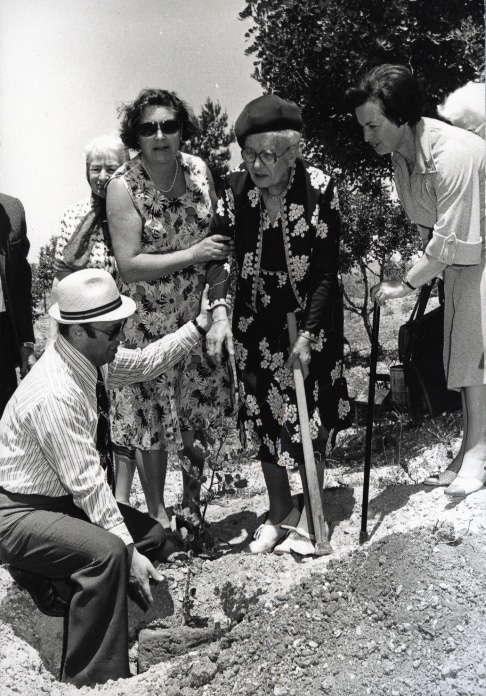
Tree planting ceremony in honor of Hendrik and Margarete Pouw. Yad Vashem, May 2nd, 1978 – Source: The Righteous Among The Nations
Liberation and Reconstruction of Dachshund Breeding
Only one servant’s house was spared from the action of the so honourable and brave German soldiers, because the soldiers were told that it was inhabited by an old woman suffering from a contagious disease.
After the liberation, Enny’s Hoeve was gradually rebuilt and Mrs Pouw set to work again with some difficulty. With a few dogs that she had given away before the attack and now bought back, a few dogs that found their way back from the woods and one or two stud dogs from her kennel that had survived the war with new owners, she rebuilt her kennel with gradually increasing success over the years in the short-haired and rough coat breed and numerous champions. Nevertheless, after the war she is said not to have regained the consistently outstanding quality of her dogs before the war. By the way, it is remarkable that Mevrouw Pouw did not want to break the baton over Germany and the Germans despite her commitment to the Netherlands and despite her wartime experiences, and that she remained connected to the German dachshund breed for the rest of her life. In 1975, the “Dachshund” still contains on page 312 the award of the “Preis van de Zeven Bergjes” given by H. and G. Pouw, Voorthuizen, Holland (kennel “van de Zeven Bergjes”), for “Short-Haired Tiger Dachshunds”.
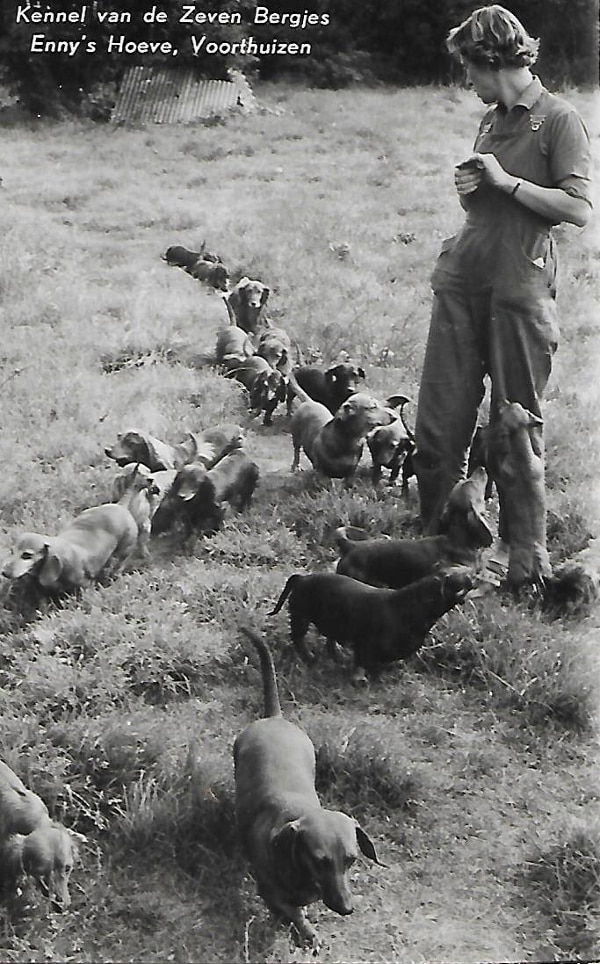
The lady mentioned at the beginning, a young woman at the time, always knew that she would do something with animals someday and fancied short-haired dachshunds. As always, however, her parents wanted her daughter to learn something sensible first and so she trained as a nurse after the war. When a colleague told her that her parents bred dachshunds, she was very impressed. The colleague’s name was Carool Pouw and so Henny van Breukelen became acquainted with the Pouw family, who eventually also gave her a dog, Erbprinz v.d. Zeven Bergjes. This dog was significant in that it prevented Henny van Breukelen from emigrating to Canada shortly afterwards. There was a fiancé, there was even already a job in Canada, but at that time there was also still a strict long-term quarantine for dogs entering Canada or else Mrs van Breukelen would have had to leave her dog behind in the Netherlands. She could not bring herself to do either and decided to stay in the Netherlands. So it came to nothing with the fiancé, the job in Canada and the emigration.
In 1952, Mrs van Breukelen moved to Enny’s Hoeve to work and live with the Pouw family and the dachshunds as kennel manager. Her parents, who were already living in Japan as entrepreneurs, had sent her a certain amount of money for her dowry, which Mrs van Breukelen now used to buy her first dogs and to found her own kennel “v.d. Hen’s Bergen”. However, she did not indulge in her real passion, the breeding of shorthaired dachshunds, but, in order not to compete with Mrs Pouw and the “Zeven Bergjes”, she switched to breeding longhaired dachshunds.
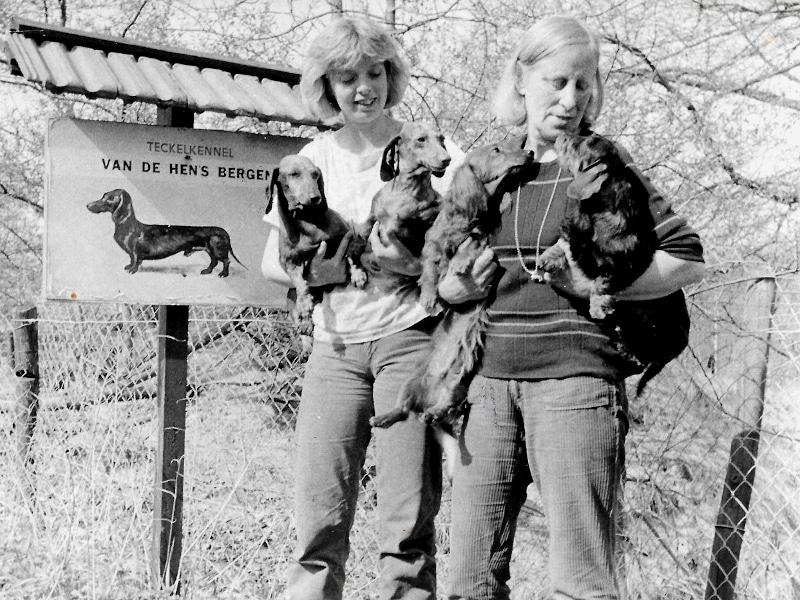
She had considerable success with these dachshunds from German bloodlines and also bred champions, but the big breakthrough eluded her, as her work for the Pouw kennel always took priority. Although she had servants at her side to take care of the dogs on a daily basis, she had to take care of all the other tasks, such as the training of the dogs and their participation in shows and tests, so that she was usually not able to show her own dogs herself and only found time for their training when all Pouw’s dogs had been taken care of. Nevertheless, she worked with dogs, that was the main thing, and she was able to accommodate her parents in the servants’ quarters at Enny’s Hoeve after their business failure in Japan.
So the years passed with the dog work and the dachshund generations passed by. Only rarely did the wiry and tall Henny van Breukelen get out of her working clothes to enjoy her only luxury, tea or coffee with veritable oodles of sugar, to which she attributes her long life. Her father died and she continued to give birth to dogs, train them, present them for tests and shows and work up the successes in the van de Zeven Bergjes kennel.
After the death of Mr Pouw in 1975, Greta Pouw gave up dachshund breeding and Enny’s Hoeve in 1976 at the persistent insistence of her children and moved to Deventer, where she died in 1989 – eleven years after the Pouw couple were honoured as Righteous Among the Nations in Yad Vashem.
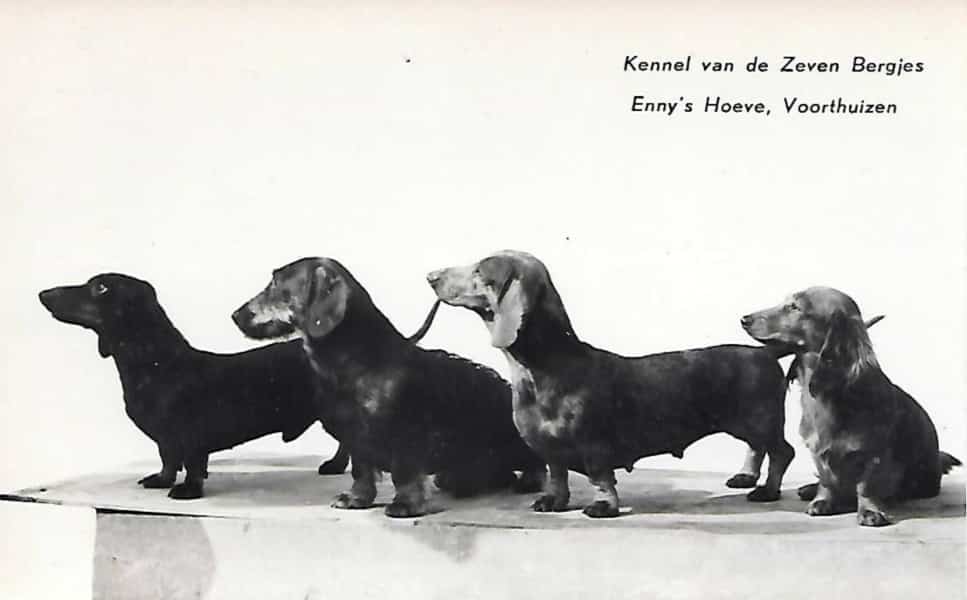
Henny van Breukelen need not have been moved by this, as she already had offers from good friends who wanted to take her and her dogs in. But what would have become of the many Pouw dogs then, especially as no overly great interest in their fate became apparent among the younger generation? The thought of simply turning around, leaving and abandoning the dogs, most of whom she had known from the first breath, seemed absurd to her, seemed a monstrosity of such magnitude that next to it the prospect of leading a comparatively quiet life with a manageable number of one’s own dogs, for whom one would then finally have enough time, lost all appeal.
Henny van Breukelen had no means that would have allowed her to take over Enny’s Hoeve. But life does not only know straight paths. Not all bends are suitable to be recounted here. Henny van Breukelen, at any rate, was lucky enough to secure the use of the servants’ quarters with the help of good friends when she sold Enny’s Hoeve for life and was thus able to keep all (!) dogs, whether rough or short-haired, from the kennel “v. d. Zeven Bergjes”, including Zunder and Schelm v.d. Birke, and to offer them a good home, even though she had to watch Enny’s Hoeve, after all also her home of many years, being demolished.
Nevertheless, Mrs. van Breukelen now threw herself into breeding short-haired dachshunds with enthusiasm and great success. And here, at the latest, we have arrived at the present time, at least for those dachshund friends who are interested in more than just the three generations of pedigrees, because dogs from the kennel v.d. Hen’s Bergen and thus also v.d. Zeven Bergjes can be found in numerous successful short-haired pedigrees throughout Europe. All the more so as Mrs. Henny van Breukelen was able to provide her excellent dogs to numerous breeders from 1976 until the nineties or helped them in any other way to get on their feet.
Among many, first of all the kennel v.h. Spaaiserhof (Mr. L.G. Spaai), or Mrs. Hilda ten Kate, who after 15 years of working for Mrs. van Breukelen founded her kennel “Abedar’s” with Deuteria v.d. Hen’s Bergen as foundation dam, or the kennel “v. Barnousch” with Granny v.h. Spaaiserhof (Schelm v.d. Birke x Foska v.h. Haveke), etc., p.p.
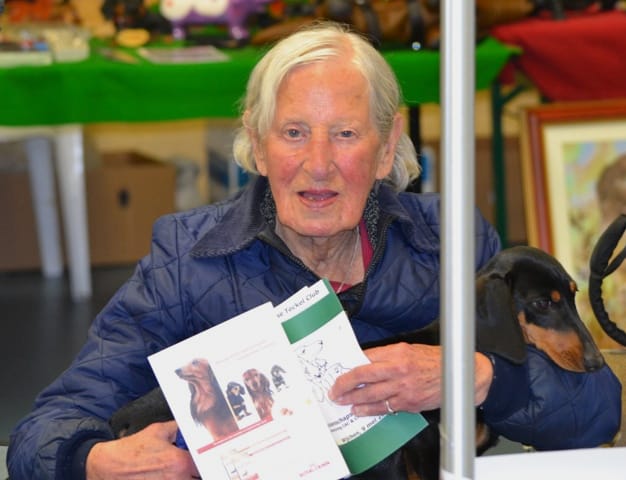
Even today, when looking at our own dogs or researching potential stud dogs, we still come across the kennel names of these each in their own way unique breeders.
What happiness it may be to have found one’s passion, to be able to share it and pass it on; to see it grow, even in someone else’s hands, and to know that it will outlast you and go its own way! As breeders, we are all part of this tradition. We benefit from what our predecessors have achieved under sometimes most adverse conditions. We enjoy and endure the consequences of their decisions, whether they were decisions out of courage, necessity or ignorance. We too always have a choice. We only have to recognize and take advantage of the choices! It will be for the better or for the worse. Nothing we do today will remain without effect on our successors and especially our dachshunds. Unless new barbarians shoot them dead. Then it was all nothing.
Mevrouw van Breukelen, accompanied by her friends, has come to the end of her path. The ashes of her mortal remains have been given to nature along the paths she so often walked on Enny’s Hoeve.
You might also be interested in

